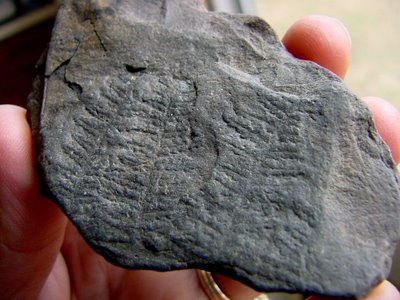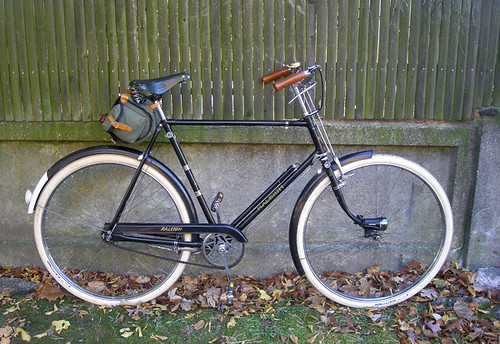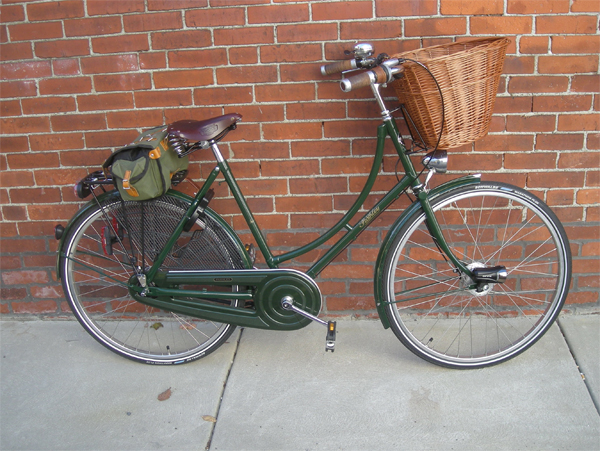
I drove out there last Sunday afternoon and when I saw the house, I realized that the above photo was reversed left-to-right. As always, you can double-click on the images to view a larger version. It's worth the extra clicks as the detail is quite good in the areas that are sharp.

So I "flipped" the image for comparison to the present-day views.

This shot was taken from across a field. The two pine trees in front of the house prevented the taking of a straight-on view. (I didn't want to go into the yard and the camera doesn't have an extremely wide angle lens anyway.)

A view of the house from the side.
On my visit to see Cal and Ardilla on Monday (mentioned in this post), Cal told me that one of Jonathan's granddaughters "from California" had come to the area back in the 1960s and had stopped at this house. She was able to go inside and visit with the owners. She apparently promised to send them a copy of the old photo above and wrote a letter to them in October of 1967. I'm not clear on how Cal got a copy of the letter - he stated that the granddaughter who visited did not contact any members of the Dunfee family that were living in the area at the time.
The author of the letter, Agnes Dunfee Deebel, was the third of four children born to Louis Weldon and Mary Lucretia (Cass) Dunfee who were married November 6, 1890 in Noble County, Indiana. About 1909 Louis and Mary moved with their four children to Calgary, Alberta, Canada where they lived for a few years. By 1920 the family was living in Long Beach, California. Agnes is the grandmother of my correspondent, Roger Waller, who provided me with the old photo.
Below is a transcription of the photocopy of the letter (paragraph breaks and text within square brackets has been added by me):
"Dear Mrs. Murbach - At last, I obtained the 92 yr old tintype, naturally somewhat worn, and here is the print I promised you, of the original house you now own. (The tintype was reversed, left to right, so you will make that correction, please.) The house was built in 1874, by my grandfather, Johnathan Dunfee, standing by front gate. He was helped by my father, Louis Dunfee, 10 yrs old, the boy standing by the front gate.
"The lady on the porch, standing, was my grand mother, Mary Dunfee. The man sitting on the porch, my uncle David Dunfee. The girls sitting [on the porch], my aunts Wilhemina, Martha, Emily & Althea & the man standing to the left, my uncle Clinton, who used to own the property to your north.
"My father bought the 80 acres where you live when he was 26, & brought my mother Mary Lucretia Cass, 22, there as a bride. Their 4 children, Florence, Helen, myself and Ruskin, were all born in this house - right in the north west corner of your present kitchen. The smaller building directly behind your house was built 70 yrs ago, as a "summer kitchen" - (no air conditioning then).
"The roof [three words, illegible] slate, alternating bands of light grey & rose, & was considered very handsome. The shutters were dark green - and the house always white. The Catalpa trees by your front gate were planted by my father in 1900 - and the maples along your lane by my mother in 1898. Thank you for the picture you gave me, and for letting me 'tour' your home. Agnes Dunfee Deebel Oct 24 - 67"

Do you think the man older man standing by the gate is 48 years old or 20?
I do take issue with Mrs. Deebel's statement that it is her grandfather, Jonathan Dunfee, standing by the gate with the boy. My guess would be that it is her brother David who is standing by the gate with Louis and that her grandfather Jonathan is the man in the chair on the porch (in the upper left corner of the cropped portion of the photo above). If the house was built in 1874, Jonathan would have been 48 years old at the time (he was born in 1826). The fellow standing by the gate with the boy appears younger to me. Her brother David would have been 20 years of age in 1874, which I think "fits" a little better.
Jonathan Smith Dunfee was the son of James and Sophia (Hazlett) Dunfee and was born June 9, 1826 probably in Adams County, Pennsylvania. At age 5, he moved to Wayne County, Ohio with his parents and siblings. At the age of 20 "he went to carpentering for two years, and the following three acted as overseer for his widowed sister's farm in Holmes County, Ohio." He married Mary Ann Quick on October 19, 1848 in Holmes County, Ohio. He was 22 years old and she was 20.
On May 26, 1850 he purchased 80 acres of land for $720 from Silvester Alexander. It was located in the northwest half of the northwest quarter of section 17 (NW 1/2 NW 1/4 S17) in Jefferson Township, Whitley County, Indiana. This is the same parcel of land upon which he would later build the home shown in the photos above.
Two of his brothers, William Hamilton Dunfee (my 3rd great grandfather) and James Henry Dunfee, had come to Whitley County several years earlier. Other family members (his brother George, sister Catherine Tryon, and sister Sophia McNabb) had located in neighboring Noble and DeKalb counties prior to 1850. Another sister, Mary Bonnett Lovett would remain in Ohio (Holmes County) while his parents James and Sophia and two other sisters, Lucy and Sarah, would arrive in Whitley County within a few years.
Jonathan would purchase other lands, at one time owning over 400 acres in Whitley County. About 1891-1892 he and his wife moved to a home on North Chauncey Street in Columbia City where he passed away on April 22, 1900. (Mary's obituary published November 15, 1907 states that they moved to Columbia City "about 16 years ago" which, according to Agnes, is about the time that their son Louis bought the farm house.) Census records show Jonathan's occupation was that of a farmer. Apparently he was rather successful at it too. His biography published in the 1882 history of Whitley County, stated that "his farm is in a high state of cultivation and supplied with excellent buildings, and the signs of prosperity and happiness are all about him."
Jonathan's wife, Mary Ann Quick, was the daughter of David and Margaret (Oliver) Quick. She was born December 4, 1827 in Holmes County, Ohio and died at her home on North Chauncey Street in Columbia City on November 8, 1907.
Jonathan and Mary Ann (Quick) Dunfee were the parents of 7 children, all of whom remained in northeast Indiana except Louis:
- Justice Clinton (August 22, 1849 - February 26, 1927)
- Margaret Willimina (November 26, 1852 - March 22, 1941)
- David J. (October 19, 1854 - August 12, 1892)
- Martha Etta (May 21, 1857 - May 17, 1945)
- Emily Almeda (February 28, 1859 - June 6, 1933)
- Althea Mary (March 26, 1861 - November 22, 1903)
- Louis Weldon (September 12, 1864 - December 14, 1947)
For more information on the Dunfee family, see the Index to Posts, which is a compilation of all the posts that have been published here at kinexxions on the family.

 7:00 a. m. Walking over to the marsh boardwalk.
7:00 a. m. Walking over to the marsh boardwalk. 7:07 a. m. From the middle of the boardwalk.
7:07 a. m. From the middle of the boardwalk. 7:13 a. m. From the far side of the boardwalk.
7:13 a. m. From the far side of the boardwalk. 7:18 a. m. From a distance, using the telephoto feature.
7:18 a. m. From a distance, using the telephoto feature. 7:22 a. m. From the same spot as the previous photo.
7:22 a. m. From the same spot as the previous photo. 7:24 a. m. The morning has risen.
7:24 a. m. The morning has risen. 7:32 a. m. My only companions were the birds.
7:32 a. m. My only companions were the birds.


 HIGH VOLUME WATER...
HIGH VOLUME WATER...



 Melting Mount Rushmore inice aliens... Am I reaching on this one? Its MY blog...
Melting Mount Rushmore inice aliens... Am I reaching on this one? Its MY blog...












 An early René Herse mixte with twin lateral stays, (c) 1947. To me, it brings to mind a woman in a shimmering evening gown with perfect posture, holding a glass of champagne in a slender hand as she looks out into the sea. Am I anthropomorphising? Well, maybe just a little.
An early René Herse mixte with twin lateral stays, (c) 1947. To me, it brings to mind a woman in a shimmering evening gown with perfect posture, holding a glass of champagne in a slender hand as she looks out into the sea. Am I anthropomorphising? Well, maybe just a little. Beautiful lugs and fork crown.
Beautiful lugs and fork crown. Lugged connection points where the lateral stays meet the seatpost. (This is so much nicer than the welded plate behind the seatpost on my Motobecane mixte.)
Lugged connection points where the lateral stays meet the seatpost. (This is so much nicer than the welded plate behind the seatpost on my Motobecane mixte.) How amazing to see a 1940s derailleur. Notice the unusual derailleur hanger design off of the chainstay.
How amazing to see a 1940s derailleur. Notice the unusual derailleur hanger design off of the chainstay. Original
Original  I am curious about the handlebars. They seem to be Northroads, but weren't these bicycles fitted with the Champs-Élysées
I am curious about the handlebars. They seem to be Northroads, but weren't these bicycles fitted with the Champs-Élysées A close-up of the stays attachment point. I am not certain when the switchover from the continuous twin lateral stays design took place, but possibly in the late 1950s - early 1960s.
A close-up of the stays attachment point. I am not certain when the switchover from the continuous twin lateral stays design took place, but possibly in the late 1950s - early 1960s. And this is one of the later original René Herse mixte designs, again with single top tube branching off into twin stays at the seatpost, (c)1972s.
And this is one of the later original René Herse mixte designs, again with single top tube branching off into twin stays at the seatpost, (c)1972s. Stay attachment looks a bit different from the '60s model, in that the stays lie close to the main tube. Because Herse made bespoke bicycles, I am not certain whether this reflects a change in design, or a customer's request.
Stay attachment looks a bit different from the '60s model, in that the stays lie close to the main tube. Because Herse made bespoke bicycles, I am not certain whether this reflects a change in design, or a customer's request. These wrap-around seat tube lugs are not typical for a mixte. See here for more photos of this bicycle from different angles and in high resolution.
These wrap-around seat tube lugs are not typical for a mixte. See here for more photos of this bicycle from different angles and in high resolution.










